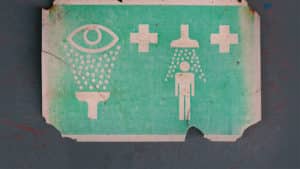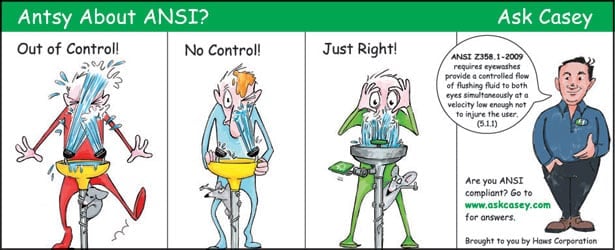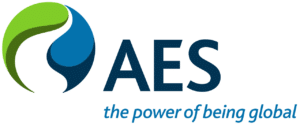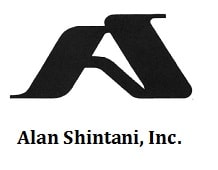
READ ARTICLE FEATURED ON OSHA’S WEBSITE HERE>>
Haws® Corporation invents, manufactures, and builds standardized and customized hydration and emergency response products. Customers vary from heavy industrial and refinery sites to schools and local municipalities. Founded in 1906, Haws® Corporation, has its global headquarters in Sparks, Nevada.
The Haws culture has a strong foundation in safety and takes great pride in continuous improvements in safety products and processes. To encourage progressive safety practices, Haws®Safety Supervisor, Melanie Mayer, and other team members often attend trainings offered by the Nevada Safety Consultation and Training Section (SCATS). “The Occupational Safety and Health Administration (OSHA), On-Site Consultation Program, and Safety and Health Achievement Recognition Program (SHARP) were discussed during one of these sessions, and we decided that we would like to pursue the award,” said Haws® Communications Specialist, Samantha Hoch.
The OSHA On-Site Consultation Program offers no-cost and confidential occupational safety and health services to small- and medium-sized businesses in all 50 states, the District of Columbia, and several U.S. territories, with priority given to high-hazard worksites. On-Site Consultation services are separate from enforcement and do not result in penalties or citations.
“We regularly use SCATS for occupational assessments when we do not have the technical capabilities in-house, said Mayer. “When a Job Hazard Analysis identifies a potential hearing or industrial hygiene risk, we rely on SCATS to perform the assessment.”
In December 2013, during the initial On-Site Consultation visit, the Nevada SCATS consultant identified two main types of hazards: electrical (misuse of power strips, extension cords, etc.) and using water hose type clamps on air lines. Haws® corrected all of the identified hazards, using cross-functional teams, comprised of operations supervisors and managers. Each team had assigned action items that they tracked and managed to completion in biweekly meetings.
People from all levels of the organization continue to contribute to workplace safety activities. For example, building maintenance personnel were trained on what to look for to prevent the electrical and air line issues. Feedback during the walkthrough also revealed that a need for consistent clarity about reading Safety Data Sheets (SDS), so an in-depth training session on reading and retrieving SDS was conducted. Now, one SDS is reviewed in each bi-weekly Production Meeting. In addition, the Safety Supervisor is available in each Production Meeting to answer questions.
Given the Haws® business history and product offering, achieving SHARP status was an organizational priority, and resources were assigned as needed. The company has benefitted in several ways from working with Nevada (SCATS). Employee engagement in the safety programs has increased. Workers’ compensation insurance premiums have decreased. “We have always had a very strong safety culture, but the involvement of line employees has increased since we decided to go for SHARP,” noted CEO Tom White. “The whole Haws® team is proud to have achieved the award, and everyone continues to work diligently to report hazards and maintain a high level of safety. It’s important that we demonstrate the value of safety culture.”
On June 11, 2018, Haws® vision and hard work were rewarded; the company joined the ranks of OSHA Safety and Health Achievement Recognition Program recognized participants. This program recognizes small business employers who have used the OSHA On-Site Consultation Program services and operate an exemplary safety and health programs. Acceptance of a worksite into SHARP from OSHA is an achievement of status that singles the company out among its business peers as a model for worksite safety and health.
To locate the OSHA On-Site Consultation program nearest you, call 1-800-321-OSHA (6742) or visit www.osha.gov/consultation.
Sources: Samantha Hoch, Communications Specialist, Haws®
Melanie Mayer, Safety Supervisor, Haws®
John Lindgren, Industrial Hygienist, State of Nevada Safety Consultation and Training Section
This nationwide event is taking place Aug. 13-19, 2018. Led by OSHA, Safe + Sound Week is meant to raise awareness and understanding of the value of safety and health programs that include management leadership, worker participation, and a systematic approach to finding and fixing hazards in workplaces. What are you doing to make your workplace as safe as can be? Want to see what others have done in the past? Click here to view a webinar put out by the US Department of Labor on YouTube.
Participant Numbers by State
OSHA and ANSI Requirements for Eyewash and Safety Showers
[via LabManager.com]
ANSI standard Z358.1 is detailed in terms of defining what is appropriate for safety showers and eyewash stations.
As lab managers and employees, we know that many inorganic chemicals (such as the mineral acids and alkalis) are corrosive to the skin and eyes. Likewise we are aware that many organic chemicals (such as acid halides, phenols, and so on) are corrosive and often toxic. Yet we Safety Guys are continually shocked by laissez-faire attitudes toward the use and maintenance of basic safety equipment by lab personnel, and the resultant unnecessary injuries.
One extreme example we constantly recall is the tragic UCLA accident just a few years ago, which resulted in a fatality from chemical burns.1 And we recently noticed a post on the American Industrial Hygiene Association pages for Lab Safety Chemical Exposure Incidents, where improper use of an eyewash resulted in a trip to the emergency room.2
The worker was using a fluorescent stain in the cytogenetics lab and felt something splash into his eyes. He was not wearing safety goggles or glasses. (D’oh!) Long story shortened, he flushed his eyes at the nearest eyewash, but they remained irritated and began to swell shut, necessitating a visit to the emergency room. Back at work a few days later, he noticed a coworker using the same eyewash to clean glassware and stainless steel trays, which were left resting in the sink in a cleaning solution. (What?!)
What does OSHA say?
In 29 CFR 1910.151 Medical Services and First Aid, it states that “where the eyes or body of any person may be exposed to injurious corrosive materials, suitable facilities for quick drenching or flushing of the eyes and body shall be provided within the work area for immediate emergency use.”3 OSHA doesn’t provide more specifics regarding what constitutes “suitable” or how “immediate” is defined. So how do we know if we are meeting the intent of the law?
Fortunately, we have the American National Standards Institute (ANSI), and their consensus standard Z358.1, last updated in 2014. This ANSI standard is very detailed in terms of defining what is appropriate for safety showers and eyewash stations. In fact, OSHA uses this reference as a guide when inspecting facilities. So let’s review what is “recommended” for acceptable safety equipment.
Safety shower specs
Begin by checking your facilities for the proper hardware, as recommended by Z358.1. Rest assured that OSHA will, should one or more agents show up for an inspection. For safety showers, the shower head must be capable of flowing 20 gallons per minute (gpm) at 30 psi and producing a 20-inch diameter spray pattern at 60 inches above the surface where the user stands. The center of the sprayhead pattern should be at least 16 inches from any wall, door, or obstruction. It is recommended that the shower head be mounted between 82 and 96 inches off the floor, with the valve no higher than 69 inches.
Eyewash specs
Eyewash stations target just the eyes and therefore have a lower flow requirement. ANSI Z358.1 recommends a flow of 0.4 gpm also at 30 psi. The nozzles should be at least six inches from any obstruction and mounted between 33 and 45 inches above the floor. An eyewash gauge should be used to verify and test the flow pattern.
Requirements for both
Both safety showers and eyewash stations must be able to provide the recommended flow for at least 15 minutes. This usually translates into having the equipment plumbed in with hard connections to the water supply. For example, a quick calculation for the safety shower at 20 gpm yields 300 gallons needed. Self-contained or personal wash devices are allowed, but they are considered supplemental units that can provide immediate flushing while transiting to the permanent fixture.
If the local climate presents potential for freezing conditions, the equipment must be designed to avoid freezing or protected against that situation. Activation valves must open within one second and remain open until intentionally closed or turned off. It goes without saying that these safety devices should be constructed of corrosion-resistant materials.
The 2014 update to Z358.1 added two important criteria. The first is that the requirement for tepid water is now defined as having a temperature of between 60 and 100 degrees Fahrenheit (15 to 37 degrees Celsius). The second change addresses simultaneous operation for combination units. This means that if you have a drench shower combined with an eyewash station, both devices must provide adequate flows and be fully operable at the same time.
Finally and most importantly, consider the location of equipment. We know you have the 10-second rule etched into your brain, as that is the most critical element when it comes to safety showers and eyewashes. This means that travel to the unit should be under 10 seconds for all hazardous areas that need this equipment. This equals about 55 feet. In addition, the drench shower or eyewash must be on the same level as the hazard and have a clear path for travel. We recommend painting or marking the floor area underneath the shower to help keep it clear. Z358.1 also recommends equipment be installed in a brightly lit area and marked with a highly visible safety sign.
Maintenance and training
The last thing you want is to rush to the eyewash or shower, only to be drenched with nasty, sediment-laden water. ANSI recommends flushing all equipment weekly to verify proper flow, and clearing the plumbing of any deposits. If your facility does not have floor drains installed, remember to bring a large, plastic trash can to catch the water. The weekly flushing can also provide a great training opportunity to refresh the operation and travel paths for your employees.
If you want to find out about the ANSI/ISEA Z358.1 significant requirements, attend our free 1-hour webinar on September 21st, 2017.
Register now and become subject matter experts of your emergency eyewash and shower equipment including weekly and annual testing. Request a certificate of attendance after the webinar.
This free webinar will cover:
• ANSI/ISEA Z358.1 significant requirements
• Important 2014 revision highlights
• Compliance best practices
• Live Q&A
WHAT: All You Need to Know About ANSI Z358.1 Webinar
WHEN: September 21, 2017 from 10am-11am PT / 1pm-2pm ET
PRESENTER: Justin Dunn, Product Specialist/Trainer and Samantha Hoch, Marketing Strategist
HOW: Register for free
Attendees will receive these complimentary materials after the webinar:
• OSHA white paper
• Weekly and Annual ANSI Checklist
• Access to On-Demand Webinar
References
1. “tert-Butyllithium Claims Fellow Chemist at UCLA,” Chemistry Blog, January 19, 2009, http://www.chemistry-blog.com/2009/01/20/tert-butyllithium-claims-fellow-chemist-at-ucla/.
2. “Lab Safety Chemical Exposures Incidents,” American Industrial Hygiene Association, https://www.aiha.org/get-involved/VolunteerGroups/LabHSCommittee/Incident%20Pages/Lab-Safety-Chemical-Exposures-Incidents.aspx.
3. “Medical Services and First Aid,” US Department of Labor, Occupational Health and Safety Administration, https://www.osha.gov/pls/oshaweb/owadisp.show_document?p_table=STANDARDS&p_id=9806.
Six Emergency Response Habits Employees Need to Develop[via OHS Online]
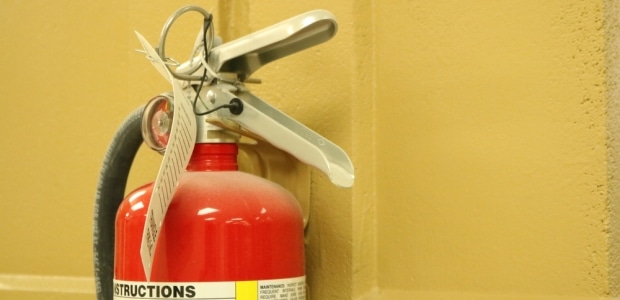 Six Emergency Response Habits Employees Need to Develop
Six Emergency Response Habits Employees Need to Develop
Employees need to refresh their training and have drills regularly so they will be able to rely on both their knowledge and their experience when emergencies happen.
By Karen D. Hamel Jul 01, 2017
If safety glasses, ear plugs, and steel-toed shoes are required in a production area, most employees who work there every day will eventually get into the habit of wearing them—especially when they receive coaching and positive reinforcement for remembering them. When the same start-up procedure is used at the beginning of the shift every day, it will become habitual, too.
Developing good safety habits can help reduce the chance of injuries. But what happens when there is an emergency or something out of the normal happens? Employees need to be just as prepared for the unexpected as they are for routine operations.
Training employees on the types of emergencies that could happen at or around the facility and what their role is during those emergencies are essential first steps in preparing them to respond appropriately. In some cases, the training may be even be required by OSHA regulations. Drills help everyone to apply what they have learned and actually walk through the response process so that it becomes familiar. The trick is having drills often enough that employees can develop emergency response habits.
Many professional responders agree that when there is an emergency, people’s actions don’t rise to the occasion—they fall back to their highest level of training. This happens because it is what they know, which makes them comfortable with the actions they need to take. That’s one of the reasons why even the most seasoned responders train and drill regularly, so that they know what they are going to do, which makes them ready to act instinctively when the need arises.
Given that even professional responders continually train and drill so that they will be prepared to act, it is wrong to assume that employees will instinctively know what to do when there is an emergency. Just like the firefighters, hazmat team, ambulance crew, or anyone else who may be called for assistance, employees need to refresh their training and have drills regularly so that they will be able to rely on both their knowledge and their experience when emergencies happen.
While it is probably not realistic to train every employee to be a contingency planner who is prepared for any time of emergency that could ever happen, each employee needs to specifically know what they are expected to do during different types of emergencies. Here are a few of the basic emergency response habits every employee can develop.
Exit Routes
Some facilities have multiple types of alarms, but for many facilities, an alarm means that something is wrong and everyone should evacuate. Each employee should know where the exit routes are and where the closest exit is. In addition, they should also be able to leave the building at least two different ways.
Be sure that evacuation drills allow employees to practice using both primary and alternative routes so that they are less likely to panic if they aren’t able to use their primary route in an emergency. Employees also should know where to go after they leave the building and whom to report to after they have evacuated.
Chemical Splashes
Under OSHA’s Hazard Communication Standard, hazardous chemical containers need to be properly labeled. The information on the label provides basic information about a chemical’s hazard. But when an employee has been splashed or unsafely exposed to a hazardous chemical, Safety Data Sheets (SDS) can provide more details to better help the affected employee. Knowing where to locate SDS and how to quickly find the one that is needed allows faster response and can lessen the extent of an injury.
Eyewash Stations and Drench Showers
In areas where corrosive chemicals are used, knowing how to get to eyewash stations and drench showers quickly can literally mean the difference between a first aid incident and a recordable injury with a long recovery time. Try blindfolding employees to see whether they can reach the nearest eyewash or drench shower in less than 10 seconds.
Fire Extinguishers
Most building codes require fire extinguishers; because they need to be checked monthly, most are fully charged and ready to use. However, whether or not employees should actually use them is sometimes a debate. Some facilities develop “do not use” policies because they feel that having an employee attempt to put out an incipient fire with an extinguisher is too big of a risk. Instead, they want their employees to pull the fire alarm and exit the building.
For facilities that do not have this type of policy, annual fire extinguisher drills can help them to remember to pull, aim, squeeze, and sweep. Be sure that these drills also include instruction on exiting the building if they have exhausted an extinguisher but have failed to put out the fire.
Spill Response
Most spills that happen in fixed facilities are small and can be safely cleaned up by employees in the immediate area. OSHA calls these “incidental spills.” When a spill creates an unsafe atmosphere or threatens the health of employees, it is most likely an “emergency spill” and needs to be cleaned up by employees who have been trained to OSHA’s Hazardous Waste Operations and Emergency Response (HAZWOPER) Standard.
All employees need to be taught how to quickly determine whether they are capable of cleaning up a spill or need to call in trained emergency spill responders. Volume, location, chemical properties, and levels of training are all factors that need to be taken into consideration when training employees how to determine whether a spill is incidental.
Injury Response and Reporting
Facilities that are not located in close proximity to hospitals or infirmaries need to have employees who are trained to administer first aid. While it is not necessary for every employee to receive first aid training, it is important for every employee to know what to do when someone is injured. At a minimum, every employee should know whom to report an injury to, as well as the process that will be used to investigate the root cause of an incident. Even elementary skills such as being able to retrieve the first aid kit or AED, or being able to meet the ambulance at the door and direct them to an injured employee, are helpful.
Few people ever reach the point where responding to emergencies is as instinctive as tying their shoes. But without regular emergency training and drills, response actions will never become familiar, let alone become habits. The more comfortable employees are with their roles in emergency response, the more likely they will be to follow established plans and avoid injuries.
This article originally appeared in the July 2017 issue of Occupational Health & Safety.
Emergency Response is a Matter of Time
Written and published by: Ryan Pfund, Occupational Health & Safety Magazine
January 1, 2017
In an emergency, the faster the response, the better the outcome.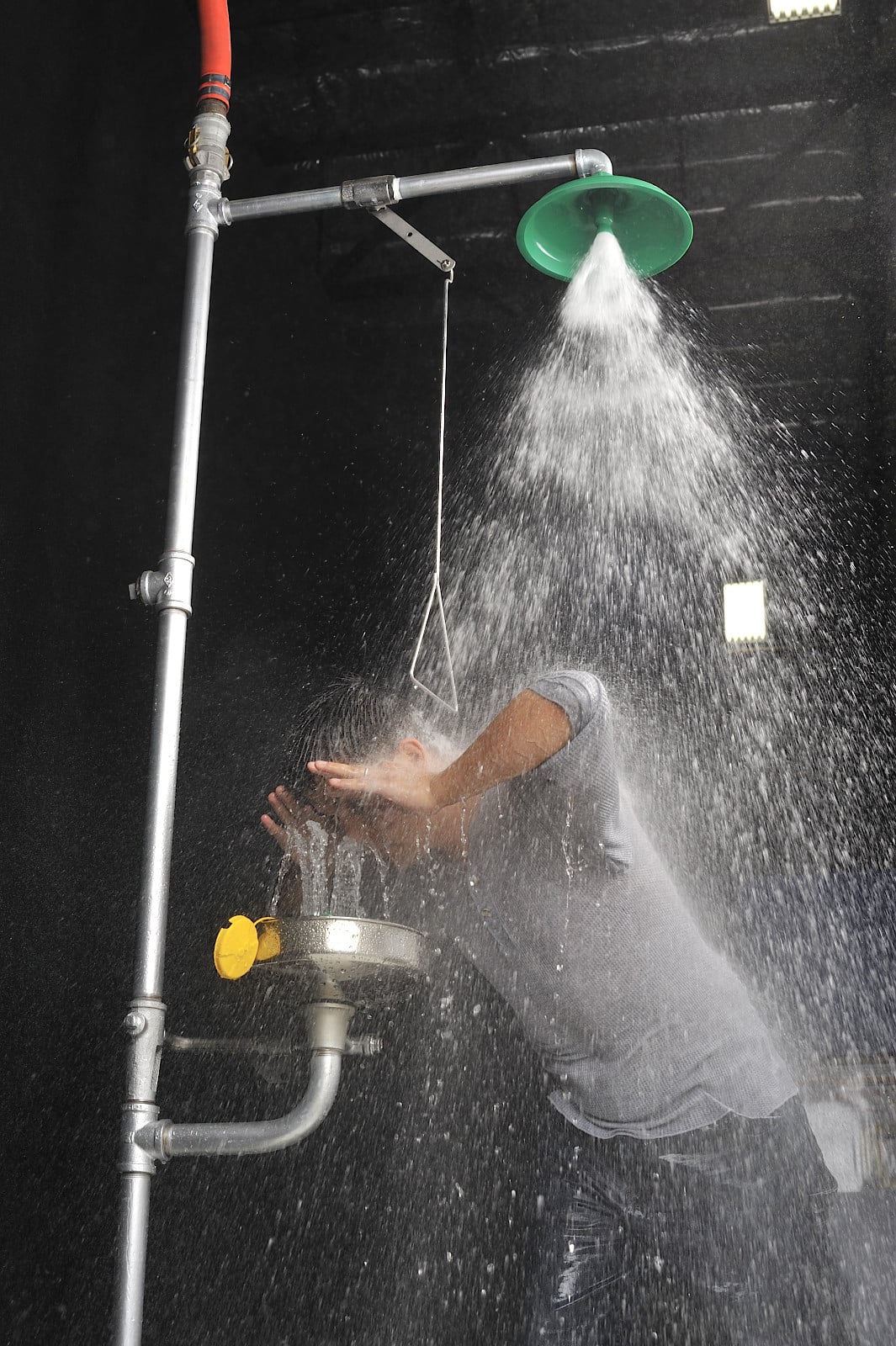
An emergency safety plan that anticipates every work site emergency and improves emergency response time is every facility manager’s and employee’s best protection. It’s difficult to think clearly and logically in a crisis, so having a well-orchestrated strategy in place that can be properly and quickly executed by employees makes all the difference.
When an employee at a work site is exposed to hazardous chemicals, taking these pre-emptive actions will help ensure the most positive outcome:
1) Providing a well-organized work site equipped with easily accessible eyewashes or drench showers
2) Minimizing the length of response time for accessing emergency equipment and drenching the employee’s affected area(s)
3) Employing emergency signaling systems to ensure immediate help is on the way, including emergency medical care
Time is clearly of the essence in stopping the exposure, alleviating discomfort and pain, and preventing further or permanent facial and bodily damage. For example, an eyewash or drench shower must be located within 10 seconds of the hazard, so the injured person can quickly and easily reach the plumbed fixture to immediately drench affected areas. Time is also a factor in the length of time one stays in the flushing fluid, which should be for a full 15 minutes as required by the ANSI/ISEA Z358.1 standard. Reaction time of emergency response personnel to swiftly gain access to the injured party is also critical in halting further injury and getting the exposed user proper medical attention.
For proper and expedient execution of a safety plan, it’s important to carefully review with employees the basics on placing and using emergency safety equipment and what to do following a co-worker’s accident. Consider these elements of emergency planning and response preparedness:
Why Use Emergency Fixtures?
Emergency safety showers and eyewashes prevent permanent eye and skin damage from chemical burns or foreign substances generated by grinding, hammering, chipping, testing, pouring, storing, transporting, and disposing operations. Proper selection, placement, and maintenance of this equipment will minimize risk of exposure while reducing the chances of catastrophic employee health impacts, work productivity, or even legal costs for the facility.
Eyewash and drench shower fixtures are placed throughout hazardous environments wherever there is risk of exposure to eye or bodily contaminants. Environments also may include inclement conditions such as heat, freezing, and airborne chemicals. Plumbed, portable, and self contained/stand-alone units should be matched to work site needs.
Where Are Proper Locations for Placement?
Each unit should be stationed close to a hazard, easily seen, and in immediate good working order. It is highly recommended to conduct a walk-through of the facility with a health or safety expert to determine proper locations and types of fixtures for each location.
Here are some fundamental placement guidelines:
- Emergency shower fixtures must be within 55 feet of a potential hazard and must take no more
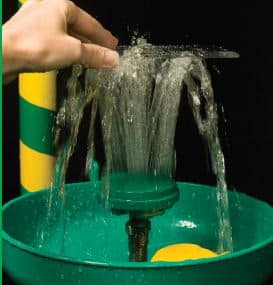 than 10 seconds to access. In addition, the path to the fixture must not be obstructed by debris or other hazards that could interfere with the fixture’s use.
than 10 seconds to access. In addition, the path to the fixture must not be obstructed by debris or other hazards that could interfere with the fixture’s use. - The area around the fixture should be well lit to optimize visibility, and each fixture should be identified with a highly visible sign.
- If a potential chemical spill in an area is likely to affect multiple workers, a sufficient number of fixtures should be made available.
- If the worker’s ability to walk or move could be impacted by the chemical exposure, the fixture should be placed closer to the worker.
- The equipment must be on the same level on which the user is working.
When Is an Eyewash Needed vs. a Drench Shower?
After potential hazards throughout a work site are identified, consider how the types of fixtures can best address the risk:
- Emergency eyewash stations
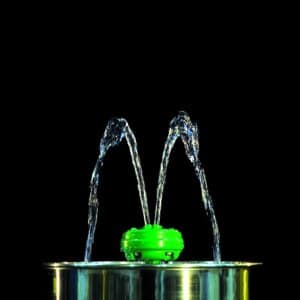
- effective for spills, splashes, dust, or debris likely to affect only the eyes
- provides a controlled flow of water to both eyes simultaneously
- delivers an uninterrupted, 15-minute supply of tepid water; plumbed units can supply a greater volume of water available to the user—between 7.5 and 19.0 liters (2.0 and 5.0 gallons) per minute
- Emergency eye/face wash stations
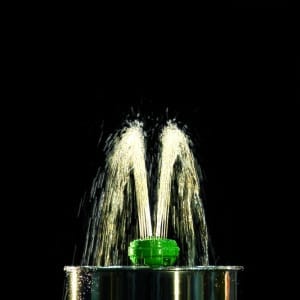
- used when the entire face is at risk from spills, splashes, dust, and debris
- irrigates the eyes and face simultaneously
- provides a large distribution pattern of water (minimum 11.4 lpm/3.0 gpm) to effectively rinse the entire face
- Drench showers
- used when larger areas of the body are at risk
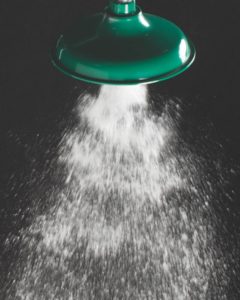
- flushes a larger portion of the body but is not appropriate for the eyes (a combination eyewash and drench shower may be used to simultaneously flush the eyes and rinse larger areas of the body)
- used when larger areas of the body are at risk
Drench showers work by simply pulling down on the drench shower handle while standing directly underneath the shower head. New technology will effectively drench the entire body without needing to move around in the spray pattern. Eye and eye/face washes work by pushing a handle or lifting a bowl cover. The face is then positioned directly in the flushing fluid, while the user holds their eyelids open with their fingers. The user should roll his or her eyes around while positioned directly in the eyewash streams to effectively rinse the entire eye. Ensuring employees are trained on the proper and expeditious use of equipment is essential to worker safety.
For both eyewashes and drench showers, it’s essential to have direct and on-demand access to tepid water—per ANSI requirements—to encourage a full and effective flush of the affected area. ANSI Z358.1-2014 stipulates that an injured worker remains beneath the drench shower and/or flush his eyes/face for a minimum of 15 minutes to increase the likelihood of a complete and successful treatment and minimize the possibility of inadvertently spreading hazardous material to other areas.
What Is the Response Protocol After Someone Uses an Emergency Fixture?
Each employee should be trained on what action to take in assisting the affected employee(s) and how to report emergencies to emergency medical personnel. To help with the notification process, it is essential to have the ability to immediately send a clearly recognizable signal of an emergency that notifies others to help and/or send help. Using new signaling technology that works in tandem with each emergency fixture will quickly notify on-site workers and medical personnel and expedite the emergency response and recovery process.
Using a signaling system along with emergency fixtures is important because of common hindrances in the work site to alerting others. For example, industrial work environments don’t always allow for several people to be in the immediate area of a work site hazard. One person could be working outside alone or only a few people could be working within an expansive area or during third shift. These situations can affect co-workers’ capacities to be aware that an emergency is even happening and, therefore, impede their abilities to help the injured get follow-up medical care.
Another obstacle in providing immediate emergency response and post-medical care is the time it takes for emergency responders to be dispatched to a work site. According to NEDARC (the National EMSC Data Analysis Resource Center), the average emergency medical services response time in the United States is 9.4 minutes. The sooner EMS teams are alerted, the sooner they can attend to a work site emergency.
While all employees should be trained on what to do if a co-worker has been exposed to hazardous chemicals, they should not be relied upon to completely abate the emergency. It’s best to ensure proper medical response is provided in such a dynamic and emergent situation, and an emergency signaling system is a clear method to communicate when and where medical assistance is needed.
How Do Emergency Signaling Systems Work?
Signaling devices are connected to emergency showers and eyewashes. Upon activation of the fixtures, the signaling devices are automatically triggered to turn on a highly visible flashing light and a loud sound designed to cut through ambient noise. The signaling systems call others to help, draw attention to the precise location of need, alert management to contact first responders, and provide remote monitoring of safety equipment.
Installing an emergency signaling system is a much faster and efficient way to alert those in the immediate area, as well as managers or safety personnel in other locations, that an employee is in need of help. It’s important to make sure various alarms in the facility are highly distinctive and recognized by all employees as a signal to response actions identified in your plan.
The first seconds following eye and skin exposure are absolutely critical to minimizing worker injury, which is always the main goal of any worker safety program. Instituting a well-devised safety plan, having access to proper emergency equipment, and providing a reliable emergency signaling system can expedite response and improve the outcome of the emergency.
REPOST: Nine Safety Tips for Working with FormaldehydeWith the various uses of formaldehyde, eye and skin contact is a potential occurrence, therefore a safety shower or eyewash should be provided. Formaldehyde is just one of many chemical substances that could come in contact with the eyes or body, requiring emergency response equipment to be readily available.
by Clare Condon
[via EHS Daily Advisor]
Formaldehyde is back in the news now that the U.S. Environmental Protection Agency (EPA) has issued a new rule to control formaldehyde emissions from certain products. However, if your facility uses formaldehyde, as an environment, health, and safety (EHS) manager you have been required for a long time to safeguard your workers from formaldehyde exposure under Occupational Safety and Health Administration (OSHA) workplace safety requirements. Today we will offer some tips for working safely with formaldehyde.
Formaldehyde is a fairly common chemical substance. It’s used to make clothing, textiles, furniture, and building products. It’s also a by-product of some forms of combustion. Formaldehyde is well known as a preservative in medical laboratories, as an embalming fluid, and as a sterilizer. In addition, OSHA has found that some hair smoothing products may contain formaldehyde, may release formaldehyde at levels above OSHA’s permissible limits during use, and may be mislabeled, all of which can pose health risks to salon workers.
For airborne formaldehyde, the permissible exposure limit (PEL) is just 0.75 parts per million (ppm) of air over an 8-hour time-weighted average. Most protective measures have to be instituted at the OSHA action level of 0.5 ppm for an 8-hour time-weighted average and/or the short-term exposure limit (STEL) of 2 ppm for 15 minutes.
While formaldehyde’s most serious hazards relate to health, there are others. Exposing it to heat or flame can cause a fire or explosion, depending on how much formaldehyde a solution contains. Formaldehyde is also reactive with a number of substances. You risk a violent reaction if you mix it with strong oxidizers. In addition, you’ll get explosive compounds if you mix it with nitrogen oxide, nitromethane, perchloric acid and aniline, or peroxyformic acid.
Nine Tips for Working with Formaldehyde
Tip 1: Identify exposure risks. There are a number of ways to identify potential formaldehyde exposure risks. First, formaldehyde has a pungent odor that’s easy to recognize. It also often causes eye irritation. That’s one identifier, but you can’t depend on it. People often get used to the smell and eye irritation and stop noticing it.
Checking the label and safety data sheet (SDS) before using any substance will also alert you to formaldehyde. At the very least, it will be listed on the label. If the substance can release formaldehyde at levels above 0.5 ppm, the label must list all hazards, including respiratory sensitization and the words “May Cause Cancer.”
Tip 2: Wear the PPE. Always wear the personal protective equipment (PPE) that’s assigned, and inspect it carefully before use. If it gets contaminated, don’t take it home. It has to be cleaned or laundered before reuse. Remove it in the change room, and put it in a container labeled for formaldehyde.
Tip 3: Prevent releases. To prevent formaldehyde releases, OSHA also requires regular container inspections to look for leaks and spills. Potential spill areas have to be designed for containment and decontamination. Only trained, properly equipped people repair leaks and clean up spills. Dispose of contaminated waste and debris in sealed containers with formaldehyde hazard warning labels.
Tip 4: Prevent fires. Formaldehyde is extremely flammable. Do not use near open flames or in places where there is the potential for sparks. Do not smoke in areas where formaldehyde is used. In case of a fire, shut off supply. If possible and there is no risk to surroundings, let the fire burn itself out. In other cases extinguish with powder or carbon dioxide.
Tip 4: Prevent explosions. Formaldehyde mixes well with air and explosive mixtures are formed easily. You can prevent explosions by using formaldehyde only in a closed system with proper ventilation. Make sure the electrical equipment and lighting in areas where formaldehyde is used is explosionproof. In case of a fire in a cylinder holding formaldehyde, you can help avoid an explosion by keeping the cylinder cool by spraying with water.
Tip 5: Respond in case of inhalation. Get a formaldehyde inhalation victim to fresh air immediately. Rescuers must wear self-containing breathing apparatus (SCBA) to enter an area with very high formaldehyde concentrations. Keep the person warm and at rest and give artificial respiration if breathing has stopped. Get immediate medical attention. Serious coughing or upper respiratory irritation may require hospitalization for observation.
Tip 6: Respond in case of ingestion. Give a conscious victim milk or water to dilute the formaldehyde. Keep the person warm and at rest; for vomiting, keep the head below the hips. Get immediate medical attention.
Tip 7: Respond in case of skin contact. Remove contaminated clothing. Shower immediately after skin contact. Rinse with soap and lots of water for at least 15 minutes. Cover a skin or eye burn with a sterile bandage and get immediate medical attention. Also get checked if you have any notable eye or respiratory irritation.
[highlight]Tip 8: Respond in case of eye contact. Use eyewash immediately after eye contact. Use large amounts of water for at least 15 minutes. Remove contact lenses if easily possible. Get immediate medical attention.[/highlight]
Tip 9: Provide training. OSHA’s formaldehyde standard requires employers to train all employees who are assigned to work areas with the potential for formaldehyde exposure at or above 0.1 ppm. Employees must be trained at the time of initial assignment and at least once a year thereafter. They must also receive training whenever a new exposure to formaldehyde is introduced into the work area.
ANSI Z358.1 FAQ’S: eyewash or eye/face wash? OSHA or ANSI?Casey Hayes, Director of Haws Integrated™, is our go-to expert for questions on ANSI Z358.1. For your quick reference, Casey has responded to your most frequently asked questions to help you stay up-to-date on ANSI compliance.
What is the difference between an eye/face wash and just an eyewash?
An eyewash is specific to eyes, and the water flow rate is designed to hit only the eye surface. It is imperative that the eyewash temperature be 60° – 100° F and have a continuous flow for a full fifteen minutes. Having an eyewash with the right requirements will not only make a difference between temporary blindness and permanent blindness, but increase productivity. Nearly 2,000 eye injuries occur each day in the workplace and with only half of U.S. workplaces in compliance, the cost of an injury can be significant.
An eye/face wash will cover the eyes and a portion of the face. In addition, an eyewash has a .4 gpm minimum flow rate and an eye/face wash has a 3.0 gpm minimum flow rate.
Eye/face washes are beneficial because it’s rare that a victim only has a chemical hit the eye area so using an eye/face wash to flush more of the exposed area will only increase and enhance the emergency response.
Does OSHA use the ANSI standard?
OSHA requires the employer to provide suitable facilities for quick drenching or flushing of the eyes. While OSHA has not formally adopted ANSI Z358.1, they refer employers to the standard as a source of guidance. In other words, OSHA agrees to enforce safety standards presented by ANSI, while ANSI acts as an assistant to OSHA with safety and health standards. ANSI is recognized as an approval agency of voluntary national consensus standards.
It is the employer’s responsibility to assess the particular conditions related to the needs of the site to ensure the eye/face wash and shower unit(s) provide suitable protection for employees.
For more questions regarding ANSI Z358.1, read our white paper here.
5 Safest Companies in the United StatesOSHA states, “We have the right to a safe workplace.” Each year, EHS Today searches for the safest companies in America. Haws Corporation® gives thanks to the companies in America that value safety and who take time to invest in it’s importance.
1. The AES Corporation
Located in Peabody, Massachusetts, the AES Corporation is a global power company that continually provides affordable and reliable energy to customers. AES places safety at the top of their list by communicating with best practices, adopting official policies, and always improving safety performance. Take a look at AES’s Principles of Safety.
2. Alan Shintani Inc.
An esteemed construction company located in Waipahu, Hawaii, Alan Shintani Inc. is composed of team members who strive for excellence. Alan Shintani Inc. values being efficient in the quality of construction and consistently finishing a job on time and within the budget. With safety being a top priority, it is no wonder that Alan Shintani Inc. is the recipient of many awards including, “First Place: Excellence in Safety & Health for Small Size Company.”
3. Aqueos Corp
Aqueos from Ventura, California, is dedicated to operating in an “accident-free workplace.” Practicing in services that include Commercial Diving, Vessel contracting services, Marine Construction, and Remote Operated Vehicle (ROV), Aqueos believes that by instilling safety as the top priority, staff members are motivated to be productive. Each employee is instilled with in-house safety training and is fully equipped with all safety equipment and supplies.
4. BL Harbert International
Having global headquarters in Birmingham, Alabama, BL Harbert International is one of Alabama’s most instrumental construction companies. BL Harbert International implements a CARE program, (Controlling Activity Risk and Exposure), an internal web program that helps managers view the safety execution in real-time of all employees. The program serves as a pivotal tool to managing issues about safety and health. 
5. The Charles Stark Draper Laboratory Inc.
Draper Laboratory is dedicated to developing, designing, and extending technological solutions to the country’s challenges in security, space exploration, energy, and healthcare. The non-profit company’s policy on safety is to acknowledge the safety in all organizational activities by adhering with all safety, health and environmental regulations. Through implementing a safety program, Draper Laboratory trains all employees to work safely, mitigates risks through hazard identification and control, and keeps track of health and safety with a follow up at monthly safety meetings. 
Questions answered by ANSI subject matter expert and Director of Haws Integrated Operations, Casey Hayes.
Is testing of the safety showers and eyewashes actually required in the standard and not just the appendix?
Yes, it is part of the standard. It is not in the appendix. We talk about the weekly flush and the requirements to get the debris out and to ensure that water is available. And, we also discuss in the standard the requirements for the full ANSI annual test. The annual test ensures things like making sure we have 20 gallons per minute to the showerhead and that the spray pattern of the shower meets the requirements. Same for the eyewash. It is also when you will test to make sure it is 10 seconds from the hazard and nothing is obstructing the pathway of victim reaching the unit.
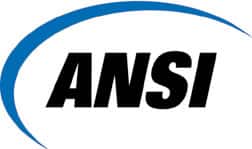
2. Does the accessible 10 second rule apply to a fast pace walk or run?
In previous revisions, there was a distance in the requirement. At one point, we had 10 seconds and 100 feet. At another point, we had 10 seconds and 55 feet. We have taken out the distance requirement so that we don’t have to determine whether it is a walk or a run. We are putting that back onto the installation aspect for you to determine what 10 seconds looks like. In the appendix, it does talk about 55 feet which is probably the right distance, but the standard does not get into the details.
3. Does EPA prohibit floor drains in college chemistry labs?
I have never been asked about this as far as EPA. I do know that the ANSI Z358.1 standard is strictly a performance standard and does not talk about floor drains because they are concerned about the performance of the shower. So, floor drains have nothing to do with that. If you look at plumbing codes, it specifically says that floor drains are not required. We believe that is due to the fact that they don’t want water that has chemicals in it to go to the sewer drain. I have never seen anything related to EPA.
4. Can you please reference the OSHA standard that requires testing once a week?
CAL OSHA says they only enforce once per month. OSHA specifically does not talk about anything in regards to the performance of the safety shower. It specifically says it must supply a suitable facility. It does not get into specifics as to what a suitable facility is. OSHA is starting to reference the ANSI standard as a guideline as to what a suitable facility is but nowhere in OSHA do they talk about the testing of the equipment. If you are building to the plumbing code, specifically references that the shower must meet ANSI and therefore the requirement for weekly/annual testing comes into play.
5. Are written records of testing required on-site?
This is outside the ANSI standard. This is what I would call a best practice. We are seeing that the testing validation is not on the tag on the shower but not being placed with the health and safety time. Testing has been enhanced so people are collecting and filing it away.
Learn more about ANSI by registering for our upcoming live web seminar on ANSI Z358.1-2014 Compliance.
OSHA regulations vary for eyewash flushing & shower drenching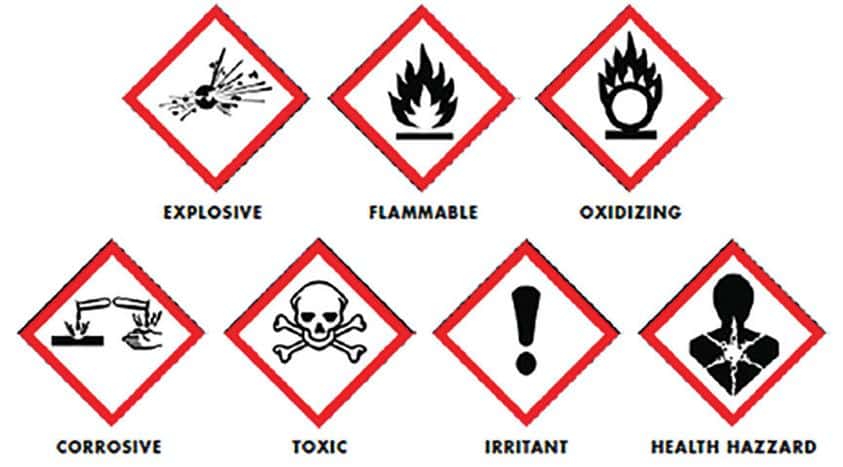 Written by: Wesley J. Maertz
Written by: Wesley J. Maertz
The question often comes up as to where OSHA calls out eyewash requirements. Emergency shower and eyewash station equipment needs are referenced in two different types of OSHA regulations. The first is applicable to all general industry or construction facilities that require the installation of emergency shower or eyewash station equipment. The second type is specific to certain industries.
Both regulation types specify where and when emergency eyewash and shower equipment must be available. Neither, however, specifies minimum selection, installation, operation or maintenance requirements. For the answers to these questions, organizations must turn to the American National Standards Institute (ANSI)/ International Safety Equipment Association (ISEA) American National Standard for Emergency Eyewash and Shower Equipment standard, (ANSI/ISEA Z358.1-2014).
General applicable regulations
When working with corrosives, drenching facilities must be readily available according to 29 Code of Federal Regulations (CFR) 1910.151(c) for general industry and 29 CFR 1926.50(g) for construction industry. Both state, “Where the eyes or body of any person may be exposed to injurious corrosive materials, suitable facilities for quick drenching or flushing of the eyes and body shall be provided within the work area for immediate emergency use.” These drenching facilities could include an eyewash, eye/face wash, shower or combination eye/face wash shower depending on the amount of possible exposure. Because OSHA does not clarify the minimum requirements for “suitable facilities,” employers often look to the ANSI/ISEA Z358.1 Standard for Emergency Eyewashes and Shower Equipment for guidance.
Specific industry applicable regulations
There are also industry specific regulations that address emergency drenching requirements. You must be familiar with these specific requirements if they apply to your workplace:
♦ Open Surface Tanks 29 CFR 1910.124(g)(2) and(3):
“An emergency shower and eye-wash station close to the dipping or coating operation. In place of this equipment, you may use a water hose that is at least 4 feet (1.22 m) long and at least 3/4 of an inch (18 mm) thick with a quick-opening valve and carrying a pressure of 25 pounds per square inch (1.62 k/cm2) or less; and at least one basin with a hot-water faucet for every 10 employees who work with such liquids.
♦ Anhydrous Ammonia 29 CFR 1910.111(b)(10)(iii)
“Stationary storage installations shall have an easily accessible shower or a 50-gallon drum of water.”
♦ Powered Industrial Trucks 29 CFR 1910.178(g)(2)
“Facilities shall be provided for flushing and neutralizing spilled electrolyte, for fire protection, for protecting charging apparatus from damage by trucks, and for adequate ventilation for dispersal of fumes from gassing batteries.”
♦ Pulp, Paper, and Paperboard Mills 29 CFR 1910.261(g)(5)
“…A deluge shower and eye fountain shall be provided to flush the skin and eyes to counteract lime or acid burns.”
♦ Telecommunications 29 CFR 1910.268(b)(2)(i)
“…Facilities for quick drenching or flushing of the eyes and body shall be provided unless the storage batteries are of the enclosed type and equipped with explosion proof vents, in which case sealed water rinse or neutralizing packs may be substituted for the quick drenching or flushing facilities. Employees assigned to work with storage batteries shall be instructed in emergency procedures such as dealing with accidental acid spills.”
♦ Formaldehyde 29 CFR 1910.1048(i)(3)
“If there is any possibility that an employee’s eyes may be splashed with solutions containing 0.1 percent or greater formaldehyde, the employer shall provide acceptable eyewash facilities within the immediate work area for emergency use.”
Consensus applicable regulation
ANSI/ISEA Z358.1-2014 is a voluntary national consensus standard that OSHA refers employers to as a recognized source for guidance. It helps users select, install, operate and maintain emergency eye wash and shower equipment. The standard is divided into five sections and each section addresses minimum performance and use requirements, as well as installation, testing procedures, maintenance and training requirements. OSHA often uses ANSI/ISEA Z358.1-2014 as a guide during inspections and may elect to issue penalties based on non-compliance.
To ensure that eyewash stations and showers are always ready when needed, it is important that the requirements for test procedures and maintenance set forth in ANSI/ISEA Z358.1-2014 be followed. The requirements for testing and maintaining eye, eye/face washes and showers are based on the manufacturer’s instructions and ANSI protocols. Generally, the manufacturer’s instructions state that the devices should be inspected tested and the results recorded weekly. Individual owners’ manuals should be looked at for the specific manufacturer’s guidelines.
Determination of a corrosive material
Within the general guidelines, occasionally the question comes up as to whether OSHA requires eyewashes for anything other than injurious corrosive chemicals. In a May 5, 2004 letter of interpretation, OSHA states: “As the standard states, an eyewash and/or safety shower would be required where an employee’s eyes or body could be exposed to injurious corrosive materials. If none of the materials used in this work area is an injurious corrosive (as indicated by the Material Safety Data Sheet (MSDS) for each product), then an emergency eyewash or shower would not be required pursuant to 1910.151(c) and 1926(g)”
Corrosive material is present in many workplaces either by themselves or contained in other materials. It is a good idea to refer to several sources to determine if a chemical is considered a corrosive to OSHA’s definition as it applies to eyewashes.
One of the easiest ways to identify if a chemical has corrosive properties is to use OSHA’s Hazard Communication Standard (29 CFR 1910.1200) and the Globally Harmonized System of Classification and Labelling of Chemicals (GHS) as a guide. The universal symbols/pictograms used on labels and containers provide clear indications if a chemical is a corrosive.
Another source to identify if a chemical is corrosive is the Safety Data Sheet (SDS). Section 2 of the SDS will quickly provide the same information found on the shipped container label including the pictogram and precautionary statements. Section 9 of the SDS provides more details about the physical properties of the chemical including pH, which is the measure of how basic or acidic the chemical is on a scale of 0-14. A rating below seven is more acidic and above seven is more basic.
One other source to reference is the NIOSH pocket guide. The pocket guide presents key information such as pH in abbreviated or tabular form for chemicals or substance groupings that are found in the work environment.
View Emergency Equipment Product Solutions here>>
[via ISHN]
Haws Supports United Association International Apprentice ContestUNITED ASSOCIATION PLUMBERS AND PIPEFITTERS INTERNATIONAL APPRENTICE CONTEST 2015
“The United Association International Apprentice Contest involved 7 apprentices; 5 from the United States in 5 different regions, 1 from Canada, and 1 from Australia. The contest is a 5 day event beginning at 7:30 am each day and concluding at 5:00 pm. Each candidate must complete 100 questions on the theory of plumbing, principles of plumbing code, all within a specified time limit. Next the candidates perform hands on layout of sleeves, plumbing fixtures, piping, piping supports according plumbing print presented to each candidate. Last the candidate’s final set fixtures, assemble piping as related to waste, vents, and domestic water piping comprised of cold water, hot water, and tempered water. Each piping assemble consists of various type of joints.
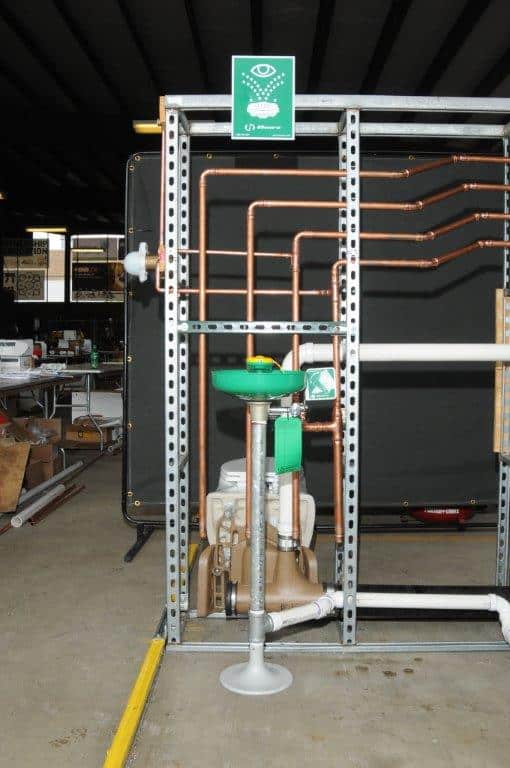 In reference to the Haws emergency eye/face wash model 7261-7271, each candidate was required to verify the exact location of the fixture according to prints presented, secure the fixture to the floor, install the drain piping to the plumbing system, install a tempered water solution to the eye/face wash fixture. Once completed, the plumbing judges would verify all dimensions, inspect all piping to ensure it was installed in a workmanship manner; i.e. straight, level, plumb. Each candidate received a point value for proper installation of the fixture, piping to the fixture, and proper securing of pipe supports. Last the OSHA certified inspector witnessed proper installation of the emergency eye/face wash.
In reference to the Haws emergency eye/face wash model 7261-7271, each candidate was required to verify the exact location of the fixture according to prints presented, secure the fixture to the floor, install the drain piping to the plumbing system, install a tempered water solution to the eye/face wash fixture. Once completed, the plumbing judges would verify all dimensions, inspect all piping to ensure it was installed in a workmanship manner; i.e. straight, level, plumb. Each candidate received a point value for proper installation of the fixture, piping to the fixture, and proper securing of pipe supports. Last the OSHA certified inspector witnessed proper installation of the emergency eye/face wash.
In closing, this is the first time that the International Al Apprentice Committee incorporated the emergency eye/face wash into the contest. It was a great addition to the contest and we will again continue to utilize the Haws emergency eye/face wash as an integral part of the 2016 contest as well as future years. The United Association sincerely appreciates donation to the contest and will continue to display the Haws banner as an important sponsor of the contest.”
Jerome D. O’Leary
Apprentice Contest Chairman
Paragraph (c) of OSHA’s Occupational Safety & Health Standards – 29 CFR 1910.151 (Medical services and first aid.) requires “where the eyes or body of any person may be exposed to injurious corrosive materials, suitable facilities for quick drenching or flushing of the eyes and body shall be provided within the work area of immediate emergency use”.
A recent OSHA Info sheet details the adverse side effects caused by contaminated water from improperly maintained emergency eyewash stations.
According to the fact sheet, organisms including Acanthamoeba, Pseudomonas and Legionella thrive in stagnant, untreated water and are known to cause infections when they come into contact with the eyes and skin or if they are inhaled. The fact sheet specifies that workers using emergency equipment following an eye injury may be more susceptible to infection.

